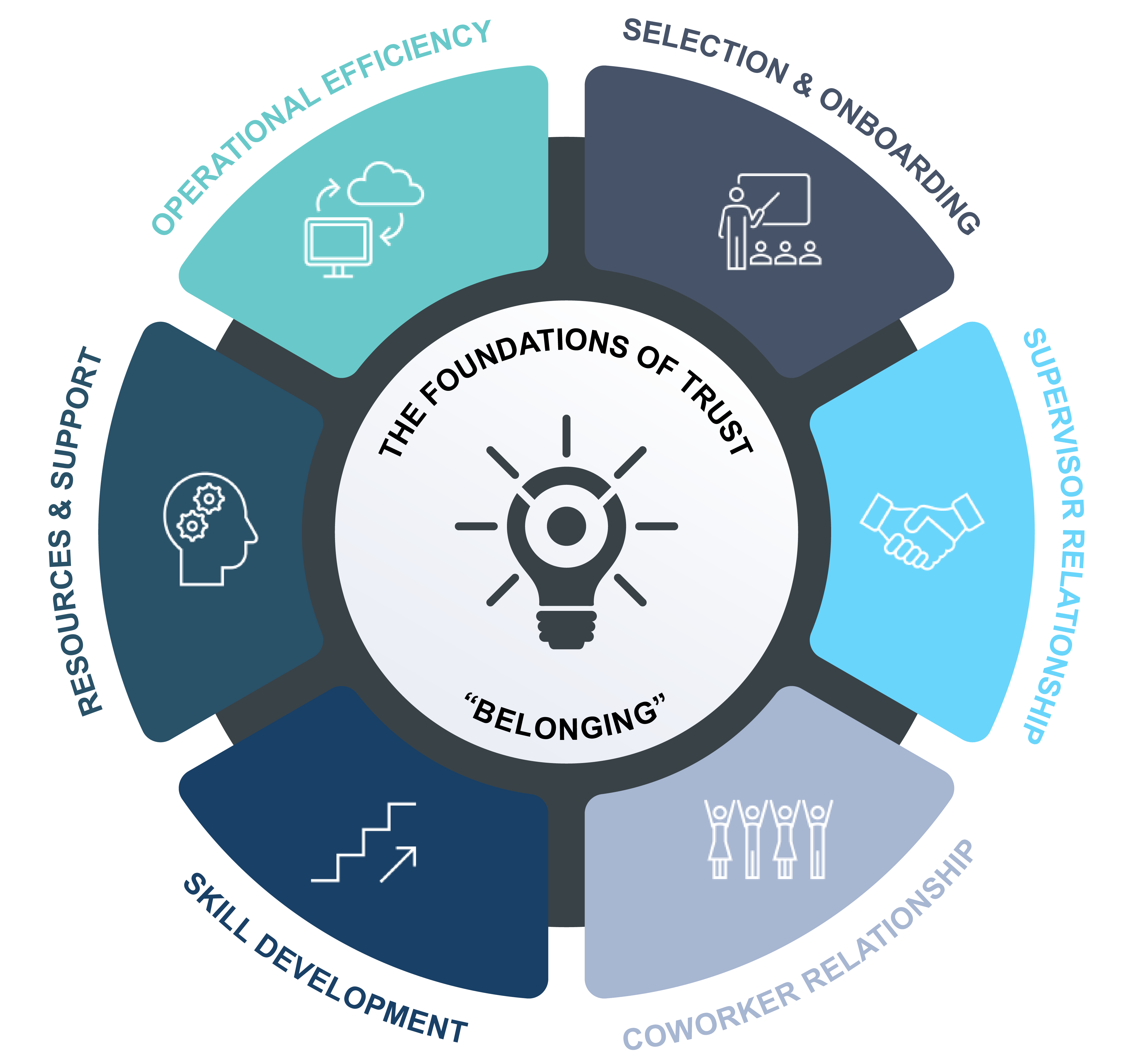The Human Capital Ecosystem™ is a framework to help organizations attract, retain, and engage talent. An “ecosystem” is a system of interdependent pieces. Like an ecosystem in nature, many interconnecting components are linked together. They interact with each other and with their environment to create fully engaged individuals.
This is why an organic approach to engagement is so powerful. For years we’ve heard, “Employees don’t leave their job; they leave their boss.” While that comment still holds some weight, people can love their boss and still leave. The big picture is far more complex.
Overall, the framework is user-friendly, very operational, and offers organizational flexibility. Each component has specific actions attached to it—some universally accepted and others unique to an organization. Many tools and techniques already exist in an organization. The ecosystem provides a foundation to maximize such resources.
The Components
SELECTION & ONBOARDING. How can we improve the selection process? How can we make sure the new person is successful once they begin in their role? Continuous onboarding is crucial. Aramark Healthcare+ has found that the first stay conversation needs to happen on day one. Outside the industry, Southwest Airlines invests heavily in onboarding. They make many connections with new employees the first year to get them engaged in the culture, and it pays off with extremely low voluntary turnover (under 3 percent).
SUPERVISOR RELATIONSHIP. We know supervisors work really hard. If they’re struggling, it’s not a matter of will; it’s a matter of their having too many things on their plate. How do we help them acquire the necessary skills to be successful? We’re finding that small, micro-learning, “just-in-time” training systems for supervisors appear to be effective. We’ve also realized some things have just become too complex and overwhelming to many supervisors. It’s more effective to take rounding and other techniques and make them simpler so they can be accomplished.
The idea of rounding is to develop relationships with those we lead and support. Leaders are looking for ways to regularly connect with team members in meaningful ways. It is not about frequency or overwhelming managers with a long list of questions. It’s about the quality of the interactions. Relationship Rounding™ is the centerpiece tactic for making these powerful connections, discovering exactly what people need, and taking action to provide it. Rounding is meant to be transformational, not transactional.
COWORKER RELATIONSHIP. People are deeply impacted by the quality of their coworkers. Individuals want a coworker who is a good team player, who is collaborative, who communicates well, and so forth. It’s crucial to foster “good coworker” qualities in our people. The addition of agency personnel creates additional coworking pressure, thus tools and tips to build better coworker relationships are part of the framework.
SKILL BUILDING & CAREER DEVELOPMENT. Research shows that employees, particularly Generation Z employees, are more likely to stay in a position when they feel their skill building and career development are prioritized. Yet it’s not one-size-fits-all. It’s important to take an “N=1” approach, which acknowledges that every person has their own unique needs. Our framework includes very specific techniques to make sure people feel invested in, which leads to better retention.
RESOURCES & SUPPORT (WELL-BEING). There’s been additional stress and trauma in every organization after the past few years that’s led to a renewed focus on mental health/wellness. In healthcare, we’re fortunate to offer great benefit packages and a variety of user-friendly mental health and well-being resources. However, only a small percentage of individuals use them. By removing the stigma around mental health and training leaders to create safe environments for sensitive conversations, we can ensure people get the help they need. And by mastering the tools and tactics that replenish cultures, we can create the kinds of organizations where mental health issues and burnout are less likely to take hold and people are more likely to utilize the well-being resources available.
Another aspect of supporting staff is taking steps to help keep them physically safe. This has always been important, but COVID-19 has brought a new urgency to the issue. Our framework places a strong emphasis on safety.
OPERATIONAL EFFICIENCY. Great organizations make sure they have the systems, equipment, and staffing to allow people to do their best work. No one is perfect, but are we improving? Are we proactively removing “pebbles in the shoe” that wear people down over time? Are we communicating our actions so people feel their concerns are listened to—and that we care about giving them a workplace that works?
How They Work Together
All components are important. They’re also interconnected. When components are working together, it leads to a proactive organization.
While an individual’s journey will always begin with Selection & Onboarding, the ecosystem does not operate in sequence. Individuals and organizations will find different components require more emphasis based on their unique situation. Leaders can focus where they need to focus when they need to focus, based on their diverse workforce and their unique needs.
This is a flexible framework, because every organization is different. Every leader is different. Every caregiver is different. This framework allows you to adjust to suit your needs at the moment. Each component lends itself to supporting tools, tactics, and skill building, so each person sees and feels the organization’s commitment to them.
The Human Capital Ecosystem™ provides a framework for us to spark, increase, and sustain the engagement of the wonderful people who have accepted the calling and who dedicate their working lives to making a difference. Healthcare organizations have always wanted the same thing: to optimize the talent of the workforce as well as the desire to be helpful and useful. This ecosystem can help us achieve that goal.






